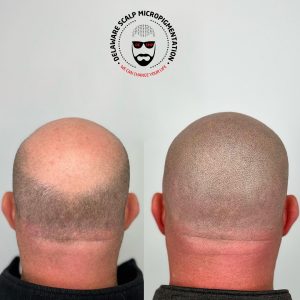Hair loss can be a distressing experience for anyone, but it’s particularly common among men. Whether it’s due to genetics, age, or various medical conditions, losing hair can take a toll on one’s self-esteem and overall well-being. Fortunately, there are numerous treatments and solutions available for combating hair loss, and one of the most innovative and effective options is scalp micropigmentation (SMP). In this comprehensive article, we’ll delve into the world of SMP, exploring what it is, how it works, its benefits, and what to expect if you decide to undergo this life-changing procedure.

Understanding Hair Loss in Men
Before we dive into the details of scalp micropigmentation, it’s essential to grasp the underlying causes and types of hair loss in men. Hair loss is a natural part of the aging process, and it often begins as early as the late teens or early twenties for many men. While some degree of hair loss is entirely normal, excessive hair thinning and balding can be attributed to various factors, including:
- Genetics: Male pattern baldness, also known as androgenetic alopecia, is the most common cause of hair loss in men. This condition is inherited from family members and typically results in a receding hairline and thinning crown.
- Hormones: Hormonal changes, such as an increase in dihydrotestosterone (DHT), can contribute to hair loss. DHT shrinks hair follicles, leading to thinner and shorter hair growth.
- Age: As men age, their hair follicles naturally decrease in size, leading to thinner and less dense hair.
- Medical Conditions: Certain medical conditions, such as alopecia areata, can cause hair loss. Additionally, treatments like chemotherapy may result in temporary hair loss.
- Stress and Lifestyle: High-stress levels, poor nutrition, and unhealthy lifestyle choices can also contribute to hair loss.
Introducing Scalp Micropigmentation (SMP)
Scalp micropigmentation is a cutting-edge cosmetic procedure designed to address the concerns of hair loss in men. Often referred to as “hair tattooing” or “hair replication,” SMP is a non-invasive and highly effective technique that mimics the appearance of a closely-shaved head of hair. This procedure involves the application of pigmented ink dots to the scalp, creating the illusion of a fuller head of hair.
Benefits of Scalp Micropigmentation
Scalp micropigmentation offers a range of benefits that make it an attractive option for men dealing with hair loss:
- Natural Appearance: SMP creates a remarkably realistic illusion of hair follicles, making it difficult for anyone to discern that you’ve undergone the procedure.
- Non-Invasive: Unlike surgical hair restoration procedures, such as hair transplants, SMP is non-invasive and does not require any incisions or anesthesia.
- Minimal Downtime: Recovery time is minimal with SMP, allowing you to return to your daily activities quickly.
- Low Maintenance: Once the SMP procedure is complete, it requires minimal maintenance. There’s no need for daily hair care products or frequent touch-ups.
- Suitable for All Stages of Hair Loss: Whether you have a receding hairline, thinning hair, or are completely bald, SMP can be tailored to your specific needs.
- Boost in Confidence: Many men who undergo SMP report a significant boost in self-confidence and self-esteem. Having a fuller head of hair can positively impact various aspects of one’s life, including personal and professional relationships.
- Affordable: Compared to surgical options like hair transplants, SMP is a cost-effective solution for hair loss.
- No Age Restrictions: SMP is suitable for men of all ages, making it a versatile option for combating hair loss.
SMP vs. Other Hair Loss Treatments
To truly appreciate the benefits of scalp micropigmentation, it’s essential to compare it to other hair loss treatments commonly pursued by men:
- Hair Transplants: Hair transplant surgery involves surgically removing hair follicles from one part of the body and implanting them into the scalp. While effective, it can be expensive, invasive, and may require multiple sessions.
- Medications: Medications like finasteride and minoxidil can help slow hair loss and promote regrowth in some cases. However, they must be used continuously, and results vary from person to person.
- Wigs and Hairpieces: Wearing wigs or hairpieces is a non-surgical option for concealing hair loss. However, they can be uncomfortable and require regular maintenance.
- Hair Growth Laser Therapy: Low-level laser therapy (LLLT) devices are used to stimulate hair follicles. While some users report positive results, the effectiveness of LLLT is still debated among experts.
In comparison, SMP offers an excellent balance of effectiveness, affordability, and minimal invasiveness, making it a compelling choice for many men.
What to Expect During SMP
If you’re considering scalp micropigmentation, it’s essential to know what to expect throughout the entire process. Here’s a detailed breakdown of what you can anticipate:
- Consultation:
During the initial consultation, you’ll discuss your hair loss concerns and goals with the SMP specialist. They will examine your scalp, evaluate the extent of your hair loss, and determine whether you’re a suitable candidate for SMP. You’ll also have the opportunity to ask questions and address any concerns you may have.
- Design and Planning:
After the consultation, the SMP specialist will work with you to design a personalized treatment plan. This includes creating a customized hairline and determining the appropriate hair density to achieve the most natural-looking results. The design phase is crucial for ensuring that the final outcome aligns with your expectations.
- Pigmentation Sessions:
The actual SMP procedure consists of several sessions, typically spaced apart to allow for proper healing. During each session, the specialist will apply pigmented ink dots to your scalp using a specialized SMP machine. The number of sessions required varies depending on the extent of your hair loss and the desired level of density. Some individuals may achieve their desired results in two to three sessions, while others may need more.
- Healing and Aftercare:
After each session, it’s essential to follow the provided aftercare instructions diligently. This typically includes avoiding sun exposure, refraining from strenuous physical activity, and applying recommended ointments to aid in healing. It’s normal to experience some redness and minor discomfort immediately after the procedure, but this should subside within a few days.
- Maintenance:
While SMP is relatively low maintenance compared to other hair loss treatments, periodic touch-up sessions may be necessary to maintain the desired look. The frequency of touch-ups varies from person to person and is influenced by factors such as skin type and lifestyle.
- Long-Term Results:
With proper care and maintenance, the results of scalp micropigmentation can last for several years. Over time, the pigments may gradually fade, but touch-up sessions can help refresh the appearance. The longevity of SMP makes it an attractive option for those seeking a long-term solution to hair loss.
Choosing the Right SMP Specialist
Selecting the right SMP specialist is crucial to achieving the best possible results. Here are some essential factors to consider when choosing an SMP practitioner:
- Experience: Look for an SMP specialist with a proven track record of successful procedures. Experienced practitioners are more likely to deliver high-quality results. Ensure that the specialist has the necessary training and certifications to perform SMP. Ask for before-and-after photos of previous clients to assess their work.
- Consultation: Schedule a consultation with the specialist to discuss your goals, concerns, and treatment plan. Pay attention to their communication skills and willingness to address your questions.
- Clean and Safe Environment: Visit the clinic or studio where the procedure will take place to ensure it meets cleanliness and safety standards.
- Cost: While cost should not be the sole deciding factor, it’s essential to understand the pricing structure and what is included in the package.
- Personal Comfort: Choose a specialist with whom you feel comfortable and trust. Effective communication and a good rapport with the practitioner are vital for a successful SMP experience.
Potential Side Effects and Risks
As with any cosmetic procedure, there are potential side effects and risks associated with scalp micropigmentation. It’s crucial to be aware of these and discuss them with your SMP specialist before undergoing the procedure. Common side effects may include:
- Redness and Swelling: Some redness and swelling are normal immediately after SMP sessions. These typically subside within a few days.
- Itching and Discomfort: Itching and discomfort may occur during the healing process. It’s essential to avoid scratching or picking at the treated area to prevent complications.
- Fading: Over time, the pigments used in SMP may fade, requiring touch-up sessions to maintain the desired look.
- Allergic Reactions: While rare, some individuals may experience allergic reactions to the pigments used. It’s essential to discuss any known allergies with your SMP specialist before the procedure.
- Infection: Proper aftercare and hygiene are crucial to minimize the risk of infection. Follow the provided aftercare instructions diligently to reduce this risk.
Overall, the risks associated with scalp micropigmentation are relatively low when performed by a qualified and experienced specialist. It’s essential to choose a reputable practitioner and adhere to recommended aftercare practices to minimize potential complications.
SMP for Different Hair Loss Patterns
Scalp micropigmentation is a versatile solution that can be tailored to address various hair loss patterns in men. Here’s how SMP can be used to target specific concerns:
- Receding Hairline: SMP can create a natural-looking hairline that frames the face and conceals a receding hairline. The ink dots are strategically placed to replicate the appearance of hair follicles, giving the illusion of a fuller hairline.
- Thinning Hair: For men with thinning hair, SMP can increase the appearance of hair density, making the hair appear thicker and fuller. By adding pigmented dots between existing hair follicles, the scalp appears less visible.
- Balding Crown: A common concern for men is a balding crown. SMP can effectively camouflage this area by creating the look of closely-shaved hair follicles across the scalp’s surface.
- Complete Baldness: Even for those who have lost all their hair, scalp micropigmentation can provide a solution. By covering the entire scalp with pigmented dots, a closely-shaved head appearance is achieved.
No matter the extent of your hair loss, SMP can be customized to your specific needs and preferences, helping you regain confidence in your appearance.
SMP: A Life-Changing Solution for Hair Loss
Hair loss is a common concern for men, and its impact extends beyond physical appearance. It can affect self-esteem, confidence, and overall well-being. Scalp micropigmentation offers a life-changing solution that addresses these concerns with remarkable effectiveness.
Whether you’re dealing with a receding hairline, thinning hair, or complete baldness, SMP can be tailored to your specific needs. It provides a natural, non-invasive, and long-lasting solution that can boost confidence, improve self-image, and enhance your overall quality of life.
If you’re considering SMP, take the time to research and choose a qualified specialist who can guide you through the process. With the right practitioner, you can embark on a transformative journey to regain the appearance and confidence you desire. Don’t let hair loss hold you back—embrace the possibilities of scalp micropigmentation and experience its life-changing benefits.
